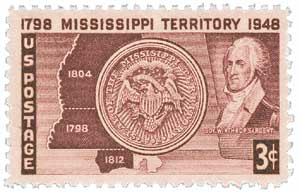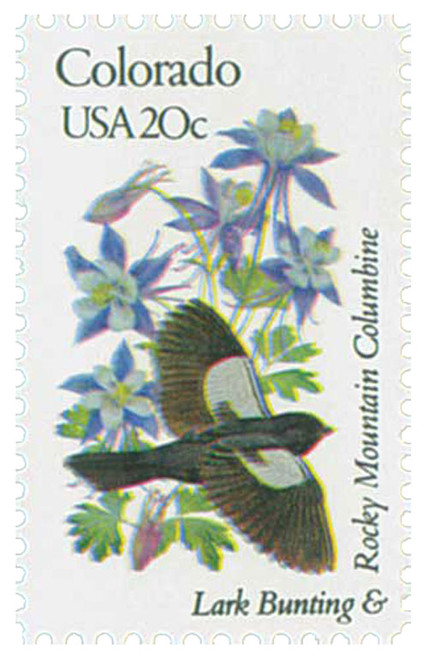
# 1976 FDC - 1982 20c State Birds and Flowers: Mississippi
20¢ Mississippi
State Birds and Flowers
City: Washington, DC and state capitals
Quantity: 13,339,000 panes
Printed By: Bureau of Engraving and Printing
Printing Method: Photogravure
Perforations: 10.5 x 11.25
Color: Multicolored
Mississippi Becomes 20th State
Prior to the arrival of white explorers, many Indian tribes lived in the region that is now Mississippi. The Chickasaw lived in the north, and the Choctaw, Natchez, Biloxi, and Pascagoula inhabited the south. Even today, evidence exists of ancient Indian civilizations. Indian mounds can be seen near Greenville and Lake George. Grand Village is an ancient Natchez Indian site.
In 1541, Spanish Explorer Hernando de Soto explored the region searching for gold. However, no gold was found in the area and Spain made no further attempts at exploration.

Then in 1682, about 140 years after de Soto’s journey, René-Robert Cavelier, Sieur de la Salle, led a group of French explorers on an expedition down the Mississippi River. When he arrived in the lower Mississippi valley on April 9, Cavelier claimed the entire region for France. The new territory (which included present-day Mississippi) was named Louisiana, after France’s Louis XIV.
In 1699, the first French settlement in the Mississippi region was founded near present-day Ocean Springs. Unfortunately, the new colonists were unable to make the region a financial success.
In 1717, John Law, a financial promoter from Scotland, devised a plan to entice investors to this new land. Law promoted Louisiana as a region with great mineral resources. Although Law’s scheme failed, by 1720, the population was much larger than it had been just a few years earlier.

For the next several decades, French, Indian, and English forces clashed for control of territories in North America, including the Mississippi Valley. The largest of these clashes, the French and Indian War, resulted in England gaining all French territory east of the Mississippi River with the exception of New Orleans. The southernmost part of the territory became part of West Florida, while the rest became part of the Georgia colony.
Although the Revolutionary War was never fought in the Mississippi region, the area was divided in its loyalty. The colonists living in West Florida stayed loyal to the Crown, while the rest of the Mississippi region supported independence.
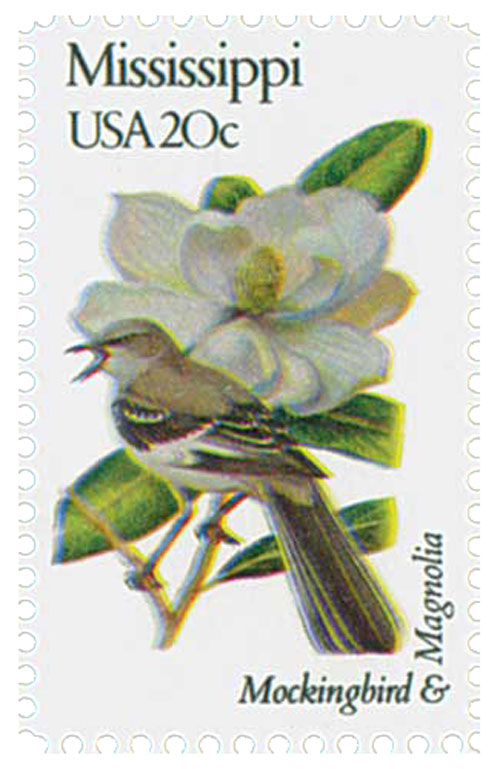
In 1781, Spain took advantage of Britain’s involvement in the Revolutionary War and seized West Florida. Two years later, Britain agreed to give the area to Spain. At the conclusion of the Revolutionary War, the part of the Mississippi region north of West Florida was ceded to the United States. The Pinckney Treaty of 1795 granted West Florida to the United States as well.
Congress organized the Mississippi Territory in 1798. Development of the Territory began to flourish in 1804, when the United States gained control of the Mississippi River. Economic development was also aided by Eli Whitney’s invention of the cotton gin in 1793 and the introduction of the improved Petit Gulf cottonseed in 1806. These two advances made Mississippi one of the wealthiest territories of the period. By 1812, the Mississippi Territory had been expanded to include all of present-day Alabama, Mississippi, and parts of Florida.
In early 1817, Mississippi was divided into the state of Mississippi and the Alabama Territory. Mississippi was admitted as the 20th state of the Union later that same year, on December 10. David Holmes was elected the first state governor. Jackson, Mississippi, became the permanent capital city in 1822.
Following Mississippi statehood, many of the Native Americans who had controlled the Mississippi Territory moved to the Indian Territory (present-day Oklahoma). Farmers from the East settled the new lands and started large cotton plantations in the rich soil. These plantations were usually operated by slave labor.
Much of Mississippi’s swampland was drained for use as farmland during this period. Levees were also built during the 1850s in an attempt to control the flooding from the Mississippi and Yazoo Rivers. In 1858, a board of levee commissioners was set up to see to the administration of these projects.
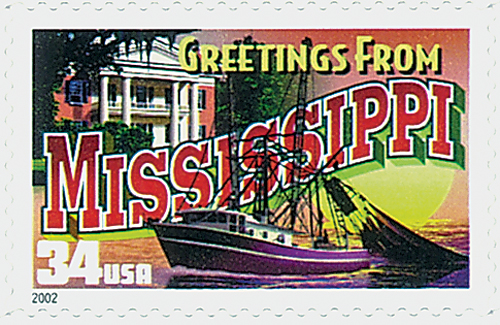
When states began to talk of seceding from the Union in 1832, Mississippi did not favor the idea. However, due to the developing debate over slavery and states’ rights, as well as the development of the Republican Party, Mississippi became the second state to secede on January 9, 1861. More than 80,000 Confederate soldiers came from Mississippi. However, the best-known Civil War figure to come out of the state was Confederate President Jefferson Davis.
Many important Civil War battles were fought in Mississippi. The most notable of these was the Siege of Vicksburg. After failing in past attempts to destroy the Confederate battery at Vicksburg, Union General Grant launched a combined army-navy operation. Federal gunboats transported troops to the shores of the Mississippi River, south of Vicksburg. These troops moved inland, drawing the Confederate forces out of their stronghold at Vicksburg and away from the body of the Confederate army. After losing several small battles, the Confederates were driven back into Vicksburg and surrounded. On July 4, 1863, they were forced to surrender to Grant’s forces. Because this battle led to Union control of the Mississippi River as well as effectively splitting the confederacy in half, it is considered one of the turning points of the Civil War.
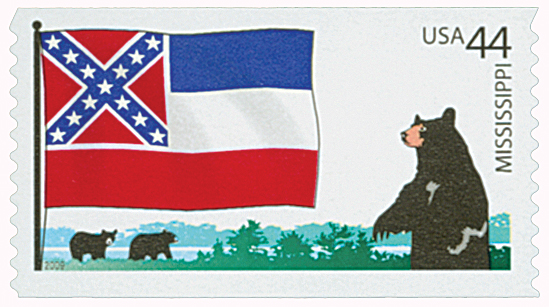
Following the Civil War, Mississippi enjoyed a period of economic prosperity. Progress was made in education, agriculture, and industry. Drainage projects were started for the purpose of farmland production. Legislation such as Balancing Agriculture with Industry (BAWI) encouraged new business growth by giving tax breaks to new industries. By the 1980s, approximately one fourth of Mississippians were employed in factories.
Today, Mississippi is still trying to effectively balance agriculture and industry. Many farmers from the delta region are unemployed, due to farm mechanization. However, new industries are still moving to the state. Legislators hope these new industries will encourage further economic development in the future.
20¢ Mississippi
State Birds and Flowers
City: Washington, DC and state capitals
Quantity: 13,339,000 panes
Printed By: Bureau of Engraving and Printing
Printing Method: Photogravure
Perforations: 10.5 x 11.25
Color: Multicolored
Mississippi Becomes 20th State
Prior to the arrival of white explorers, many Indian tribes lived in the region that is now Mississippi. The Chickasaw lived in the north, and the Choctaw, Natchez, Biloxi, and Pascagoula inhabited the south. Even today, evidence exists of ancient Indian civilizations. Indian mounds can be seen near Greenville and Lake George. Grand Village is an ancient Natchez Indian site.
In 1541, Spanish Explorer Hernando de Soto explored the region searching for gold. However, no gold was found in the area and Spain made no further attempts at exploration.

Then in 1682, about 140 years after de Soto’s journey, René-Robert Cavelier, Sieur de la Salle, led a group of French explorers on an expedition down the Mississippi River. When he arrived in the lower Mississippi valley on April 9, Cavelier claimed the entire region for France. The new territory (which included present-day Mississippi) was named Louisiana, after France’s Louis XIV.
In 1699, the first French settlement in the Mississippi region was founded near present-day Ocean Springs. Unfortunately, the new colonists were unable to make the region a financial success.
In 1717, John Law, a financial promoter from Scotland, devised a plan to entice investors to this new land. Law promoted Louisiana as a region with great mineral resources. Although Law’s scheme failed, by 1720, the population was much larger than it had been just a few years earlier.

For the next several decades, French, Indian, and English forces clashed for control of territories in North America, including the Mississippi Valley. The largest of these clashes, the French and Indian War, resulted in England gaining all French territory east of the Mississippi River with the exception of New Orleans. The southernmost part of the territory became part of West Florida, while the rest became part of the Georgia colony.
Although the Revolutionary War was never fought in the Mississippi region, the area was divided in its loyalty. The colonists living in West Florida stayed loyal to the Crown, while the rest of the Mississippi region supported independence.

In 1781, Spain took advantage of Britain’s involvement in the Revolutionary War and seized West Florida. Two years later, Britain agreed to give the area to Spain. At the conclusion of the Revolutionary War, the part of the Mississippi region north of West Florida was ceded to the United States. The Pinckney Treaty of 1795 granted West Florida to the United States as well.
Congress organized the Mississippi Territory in 1798. Development of the Territory began to flourish in 1804, when the United States gained control of the Mississippi River. Economic development was also aided by Eli Whitney’s invention of the cotton gin in 1793 and the introduction of the improved Petit Gulf cottonseed in 1806. These two advances made Mississippi one of the wealthiest territories of the period. By 1812, the Mississippi Territory had been expanded to include all of present-day Alabama, Mississippi, and parts of Florida.
In early 1817, Mississippi was divided into the state of Mississippi and the Alabama Territory. Mississippi was admitted as the 20th state of the Union later that same year, on December 10. David Holmes was elected the first state governor. Jackson, Mississippi, became the permanent capital city in 1822.
Following Mississippi statehood, many of the Native Americans who had controlled the Mississippi Territory moved to the Indian Territory (present-day Oklahoma). Farmers from the East settled the new lands and started large cotton plantations in the rich soil. These plantations were usually operated by slave labor.
Much of Mississippi’s swampland was drained for use as farmland during this period. Levees were also built during the 1850s in an attempt to control the flooding from the Mississippi and Yazoo Rivers. In 1858, a board of levee commissioners was set up to see to the administration of these projects.

When states began to talk of seceding from the Union in 1832, Mississippi did not favor the idea. However, due to the developing debate over slavery and states’ rights, as well as the development of the Republican Party, Mississippi became the second state to secede on January 9, 1861. More than 80,000 Confederate soldiers came from Mississippi. However, the best-known Civil War figure to come out of the state was Confederate President Jefferson Davis.
Many important Civil War battles were fought in Mississippi. The most notable of these was the Siege of Vicksburg. After failing in past attempts to destroy the Confederate battery at Vicksburg, Union General Grant launched a combined army-navy operation. Federal gunboats transported troops to the shores of the Mississippi River, south of Vicksburg. These troops moved inland, drawing the Confederate forces out of their stronghold at Vicksburg and away from the body of the Confederate army. After losing several small battles, the Confederates were driven back into Vicksburg and surrounded. On July 4, 1863, they were forced to surrender to Grant’s forces. Because this battle led to Union control of the Mississippi River as well as effectively splitting the confederacy in half, it is considered one of the turning points of the Civil War.

Following the Civil War, Mississippi enjoyed a period of economic prosperity. Progress was made in education, agriculture, and industry. Drainage projects were started for the purpose of farmland production. Legislation such as Balancing Agriculture with Industry (BAWI) encouraged new business growth by giving tax breaks to new industries. By the 1980s, approximately one fourth of Mississippians were employed in factories.
Today, Mississippi is still trying to effectively balance agriculture and industry. Many farmers from the delta region are unemployed, due to farm mechanization. However, new industries are still moving to the state. Legislators hope these new industries will encourage further economic development in the future.







